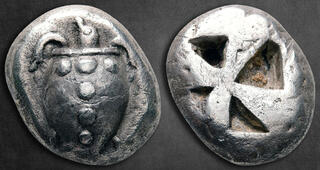| Savoca Numismatik GmbH & Co. KG > Online Auction 193 | Silver | Auction date: 28 January 2024 |
| Lot number: 43 Price realized: 2,800 EUR (Approx. 3,033 USD) Note: Prices do not include buyer's fees. | Show similar lots on CoinArchives Find similar lots in upcoming auctions on |
| Lot description: Islands off Attica. Aegina circa 525-480 BC. Stater AR 19 mm, 10,60 g Sea turtle with thick linear "T" pattern collar and row of pellets down its back / Incuse square of "Union Jack" pattern with five incuse segments, one nearly filled. Well centred, pleasant tone, Good Very Fine. SNG Copenhagen 502; SNG Delepierre 1502; SNG München 523–5; Dewing 1656; ACGC 11; Asyut Group IIIb; HGC 6, 428. In the annals of ancient Greek numismatics, the coinage of Aegina holds a place of prominence, notable for its pioneering design and deep cultural significance. Around 700 BC, Aegina, an island in the Aegean Sea, began minting its own coins, becoming one of the earliest cities to engage in such a practice. These coins, remarkable for their artistry and symbolism, offer a window into the ancient world, its economics, and its beliefs. At the heart of Aegina's early coinage is the sea turtle motif. This image, elegantly depicted on the obverse of the coins, was more than a mere decorative choice; it embodied the essence of the island itself. The sea turtle, revered as a symbol of Aphrodite, the goddess of love and fertility, resonated with the maritime identity of Aegina, a dominant naval power of its time. The depiction of the turtle was detailed and specific, with six pellets on its back arranged in a unique 'T' shape – four aligned vertically and two placed horizontally at the base. This specific arrangement might have held symbolic meaning, perhaps a nod to religious or cultural tenets, or served as a distinguishing feature in a world where coinage was rapidly becoming a medium of commerce and identity. Equally fascinating is the reverse side of these coins, characterized by the incuse square pattern. This technique, revolutionary in its time, involved punching the reverse side to create a sunken relief, divided into four simple geometric sections. The choice of such a design was not merely for aesthetic appeal; it was a testament to the craftsmanship and technological prowess of the Aeginetans in the realm of coin minting. The coins of Aegina were not just mediums of economic transaction. They were bearers of cultural identity and symbols of power. Through their trade and circulation, they facilitated not just local commerce but also connected Aegina with the wider Mediterranean world. The sea turtle, gracefully engraved on these coins, sailed across seas, transcending its role as a mere symbol to become a testament to Aegina's economic and maritime strength. Thus, the early coinage of Aegina, with its distinctive sea turtle motif and the innovative incuse square pattern, stands as a significant chapter in the history of ancient Greek coinage. These coins, beyond their value as currency, encapsulate the artistic, cultural, and economic ethos of their era, offering a glimpse into a world where every coin told a story of power, identity, and artistic endeavor. Starting price: 2000 EUR |  |


